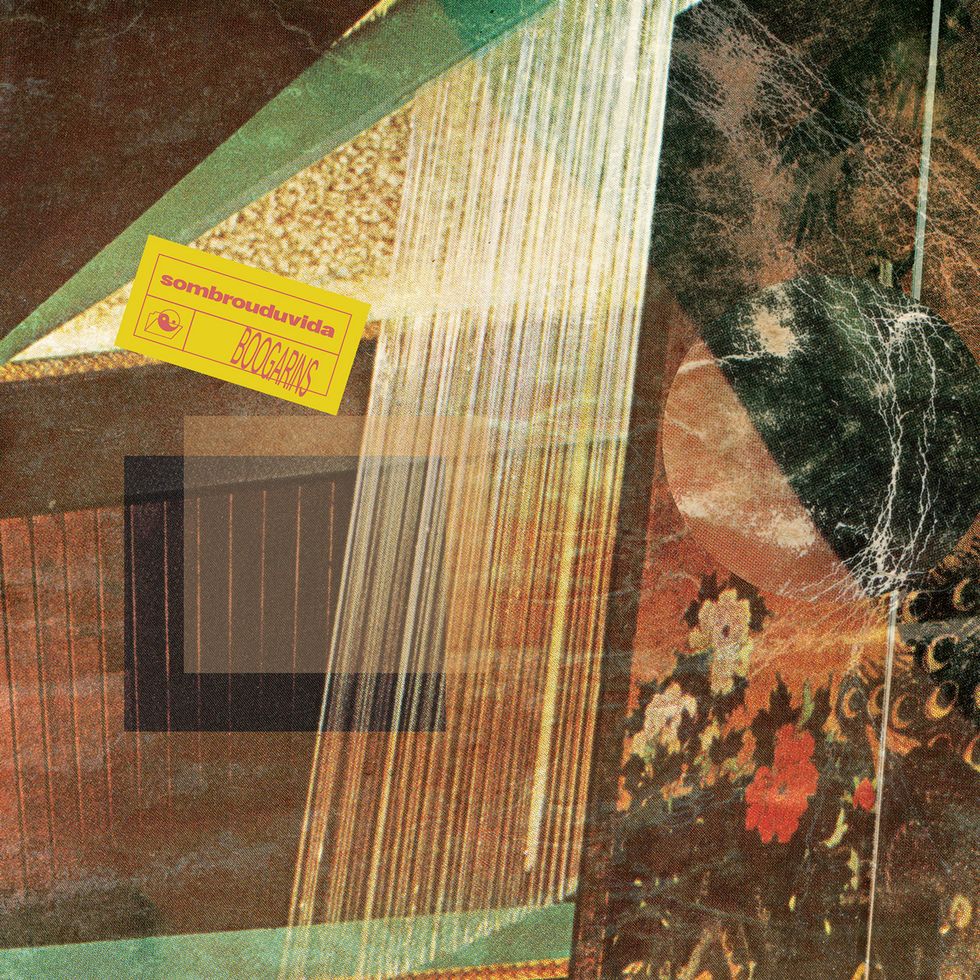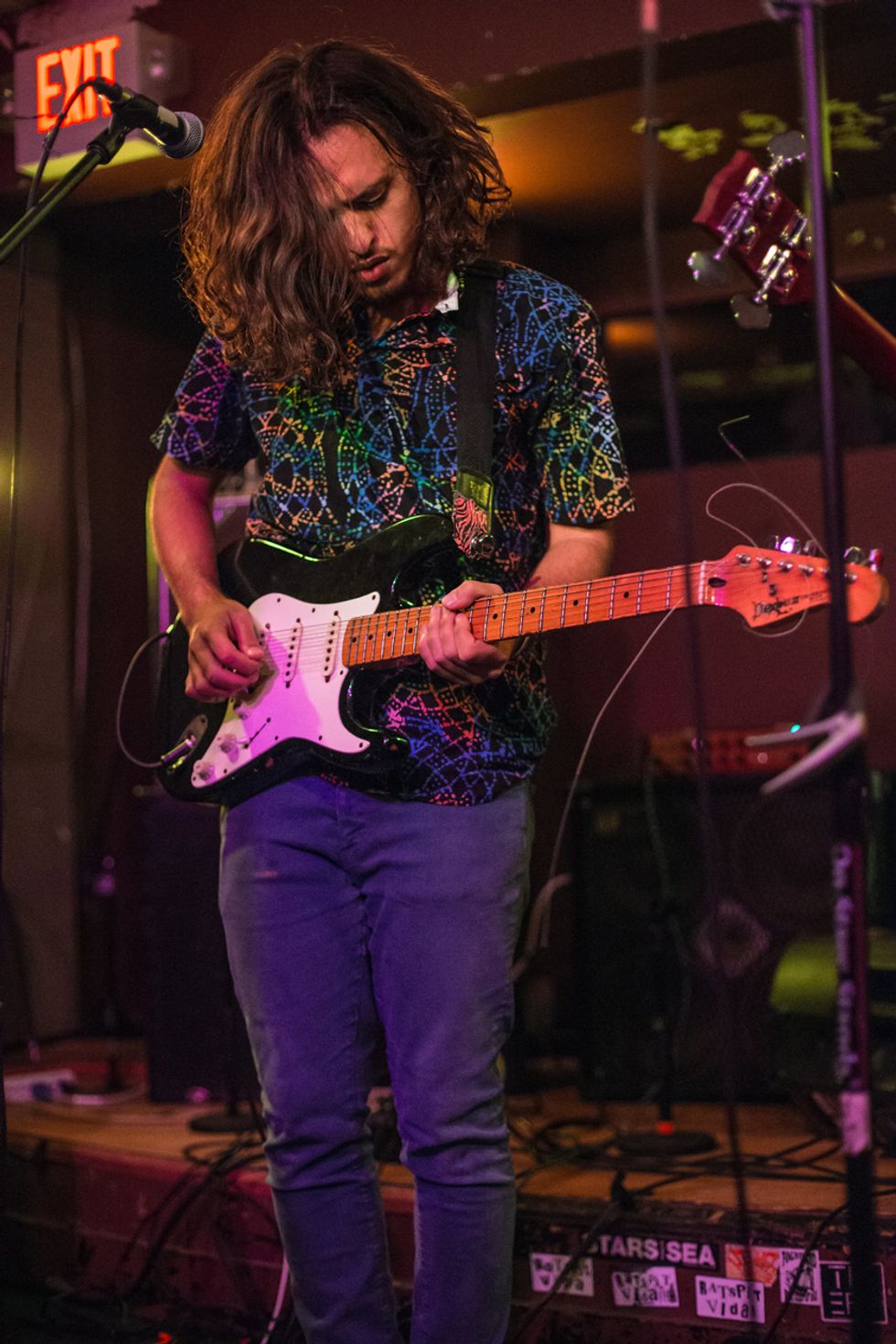The mind-altering sound of 1960s rock is as inseparable from the decade as the swirling, colorful imagery that often accompanied it. With bands like the Beatles, Pink Floyd, Jefferson Airplane, and even Jimi Hendrix taking sonic (and chemical) experimentation to new heights, the air was abuzz with swirling effects, fuzzed-out electric guitars, melodic bass lines, and enveloping reverb washes.
The psychedelic scene spread far beyond San Francisco and London, of course. In fact, Brazil also embraced their own version of the fashion, culture, and sound of the ’60s. It was known as Tropicália, and it continues today in the hands of Brazilian psychedelic rock quartet Boogarins (pronounced boog-ah-reens).
Though the band doesn’t embrace any scene’s limitations, no one embodies the sound and aesthetic of today’s Tropicália better than Benke Ferraz (lead guitar and vocals), Dinho Almeida (guitar and vocals), Raphael Vaz (bass), and Ynaiã Benthroldo (drums). Not only do they hold true to the genre’s cornerstone spacey characteristics, but they continue to experiment and evolve with electronic flourishes, forward-thinking studio techniques, and getting more out of a handful of stompboxes than most can pull from a rack of synths.
Boogarins got their start when Ferraz and Almeida met as a couple of school kids who cared more about writing songs than being in class. Inspired by each other’s passion and talent, the two formed a musical bond that followed them to college, where Almeida’s knack for catchy composition and Ferraz’s interest for the more technical aspects of guitar blossomed into the genesis of the band and their debut album, As Plantas Que Curam.
Straight out of the gate, the Boogarins sound was realized. And the unique, intense way Almeida’s fingers attack his strings and Ferraz’s ability to inject each song with just the right amount of melodic movement is at the epicenter of it all. Though their personal playing styles couldn’t be any more different, the combination has created a sonic experience that has garnered the band Latin Grammy nominations, had their music voted among the top Brazilian albums, and earned them spots on some of the world’s biggest stages.
With the nominations and three albums under their belt, it was time for Boogarins to focus on record number four, Sombrou Dúvida. From the warped guitar tones that introduce the opening track, it’s clear that the listener is in for the carefully crafted pop, expansive experimentation, and vintage-inspired vibes that have come to define the band’s sound. But upon closer investigation, this albumbreathes with a higher level of spaciousness than their earlier recordings. With such varied playing styles, unique guitar tones, and a vintage rock ’n’ roll feel, Sombrou Dúvida is a real treat for any guitarist willing to take a journey.
And that’s exactly why Premier Guitar reached out to Ferraz. Recovering at home in Brazil from his time in Austin for SXSW, he was excited to speak about the heavy influence of David Gilmour and why the studio and stage are completely different canvases for his band to paint on.
The roots of Boogarins go back to when you were quite young. Tell me more about how the band started and how you and Dinho began writing together.
Benke Ferraz: Me and Dinho went to high school together. That’s where we met. We would sit down and play acoustic guitar during our breaks between classes. We’d even skip some [laughs]. He already had a band where he sang and wrote, called Ultravespa. It was kind of ’60s-sounding. It was influenced by Brazilian mod sounds, early Beatles, and the Who. So that was pretty much his style at that time. He wrote short, major-key songs.
I was more of a “guitar magazine” kind of kid by that time. But the fact he could write his songs in Portuguese, and the fact that they were simple and cool, really empowered and inspired me to do the same. So we started writing some of the songs that would eventually end up on the first album. It was the combination of his catchy hooks and the way my more technical skills brought in different harmonies and riffs.
But the band started after high school, during first year of college. I was already adventuring into recording my own stuff. So we decided to give it a shot and record the songs we wrote back in high school.

Boogarins chose Austin, Texas, as the setting to record their fourth LP, Sombrou Dúvida. The Latin rockers self-produce their studio music, but for the first time they enlisted the help of a pro engineer, Tim Gerron.
Did you already have a clear idea of the sound you were after? Or was it more of an outcome of your two different writing and playing styles?
We were really inspired by this Brazilian songwriter from the ’90s named Júpiter Maçã [aka Jupiter Apple]. He had this early Pink Floyd, late-Beatles vibe to his early stuff. But the production style was crazy. That’s the kind of sound we had in mind.
We were always talking more about sounds than songwriting style. Usually, we were looking for riffs that could be played over and over with increasing and decreasing dynamics. And everything was created on acoustic guitars and played like that for years until we felt we could record them.
But when I found ’90s and ’00s stoner/blues bands that had distorted recordings, cool riffs and melodies, and the vocals buried in the mix with effects, I felt that I could try to record on my own. I tracked some drums and things started from that.
I hear everything from psychedelic- to surf-rock, as well as some distinctly Latin influences in your guitar parts. Who influenced the band’s vintage-vibe and varied style?
Dinho has a style that comes from this mod background. But that’s always developing into this crazy orchestrated thing that comes from his intense nylon-guitar playing. He doesn’t use guitar picks even when playing electric. I guess his biggest influences, in terms of guitar players, would be Pete Townshend and Paul Weller. But he’s gone way beyond those early influences. I can’t really define his style. I guess he can’t either.
Unlike Dinho, I wasn’t self-taught. I had a lot of music theory background and some guitar teachers. At some point I aimed at being a virtuoso kind of guitar player. But then more of my attention got caught up into songwriting and creating sonic atmospheres. David Gilmour became my biggest reference because of the way he only plays the right notes and is fast only when needed. Then Omar Rodríguez-López later inspired my use of delays.
The band has four previous albums, and there’s definitely a sonic thread through them all. What sets Sombrou Dúvida apart?
Bigger sounds. For the first time, we went to a modern studio with high-end gear. And we had a pro engineer working his ways through our production style.
Benke Ferraz plays a 1990s Squier Strat. To achieve otherworldly sounds in a live setting, he has a Rupert Neve Designs RNDI-1 at the end of his pedal chain, which doubles his amp signal. Another crucial effect is his Electro-Harmonix Deluxe Memory Boy that’s always on. Photo by Matt Condon
Speaking of your production style, you guys self-produced this one. Why did the band choose that direction on this album?
It’s always been like that with us. Our songs are always developing live. Usually what you hear onstage is very different from what we did in the studio. And usually what we do in the studio sounds a lot different from what we were doing before. The songs grow in specific ways, and it’s been hard for us to let go of that control. But I think we’re getting to the point where we’ll be able to have a guest producer and just play our parts.
You recorded the album in Austin, Texas. That’s a long way from Brazil. Why Austin? Why not somewhere closer to home?
Will Harrison is one of our OAR [Boogarins’ record label] partners. And before that, he was already one of our biggest supporters in the U.S. Since we met him at our first U.S. appearance at 2014’s South by Southwest festival, we’ve always spent a lot of time there. We also did a residency at Hotel Vegas, playing there for a month while recording our last album in a rented house. Austin has always been good to us.
Is there a lot of sonic experimentation in the studio or do you have a clear picture of what you’re after?
Most of the initial ideas come from Dinho. And sometimes the song structures are pretty clear. But sometimes I’ll hear a loop of little part I like and we’ll start building on that.
That’s the thing that sets this album apart the most. Instead of me sitting in front of the computer and going down the experimentation route individually, this time we had a proper engineer and went the experimental route together, in the studio. Then we’d go back to the house, mix it, listen to what we’d done, make notes of the good stuff, go back in there and play it differently, and then edit it to perfection. It made the post-production work way easier.
I love the guitar parts and tones on the album. They are often heavily processed, turning incredible melodic ideas into something otherworldly. How do you approach crafting those?
We treat studio and live as two completely different experiences. We’re not purists about structure, tones or effects, as long as the feel of the song is effective. So I don’t mind messing up my guitar tones with plug-ins. Then I just go insane with other effects live.
But these things change from album to album. Our second album was recorded live on tape. Those tones are all from vintage equipment. For Lá Vem a Morte, I recorded most of it plugging the guitar into a Universal Audio DI and messing with it using Ableton plug-ins.
That’s actually something we’ve been using live lately. We’ll split the guitar signal and have a [Rupert Neve Designs] RNDI-1 at the end of the pedal chain, doubling the amp signal. It helps a lot with the high end and makes the fuzz sound insane!
The album’s first single, “Somba ou Dúvida,” is a great example of your fuzz tones. It starts with a vintage-style verb and single-note guitar melody that descends into a synthesized crash. When it comes back, it’s all glitched and fuzzy.
Exactly. That’s the fuzz tones recorded through DI. But there’s some of post-production on that, too. I add some high-octave sounds by changing the pitch of the sound wave.
Another stand-out tone is the fuzz at the beginning of “Tardança.” How did you get that sound?
That’s an Ultra Fuzz pedal, by Zoom. It’s a digital fuzz that has a gate knob. So when you turn that up, it stops the sound of the signal when it’s not loud enough. It’s more used to avoid noise and feedback when you’re not playing. But once you find the right balance between the effect and the strength of the gate, it gives this rotten aspect to the sound.

Guitar and Amp
1990s Squier Stratocaster
Roland JC-120 Jazz Chorus
Effects
Boss DD-3 Digital Delay
Electro-Harmonix Deluxe Memory Boy
Dunlop Rotovibe
Zoom Ultra Fuzz
TC Electronic PolyTune
Electro-Harmonix POG
Boss SD-1 Super OverDrive
Strings and Picks
Any brand (.010–.046 with a .011 for the high E)

Guitar and Amp
Fender Mustang
Vox AC15
Effects
Boss SD-1 Super OverDrive
Electro-Harmonix Holy Grail Reverb
MXR Phase 90
Electro-Harmonix Canyon
Boss RE-20 Space Echo
Strings and Picks
Any brand (.010–.046)
Pedals definitely play a huge role in how you craft the band’s sound. What other pedals do you use?
Right now I don’t have any because American Airlines lost my luggage before I arrived for this year’s SXSW. But my main guitar pedals for my guitar tones are the Boss DD-3, which I turn on and off all the time. I set it up with a short repetition but long feedback. So my tone goes from wet to dry all the time. That’s the kind of thing I learned watching Omar Rodríguez on live videos early on with the Mars Volta.
I also always use an Electro-Harmonix Memory Boy at the end of the chain. I set it up more as a reverb/preamp. I never turn it off during a set or recording session. I use the deluxe version because it has a gain knob.
For distortions, I always have a light one and a fuzz. I used to play with an Electro-Harmonix Bass Big Muff before I got this Ultra Fuzz. The Bass Big Muff is great for leads, but it’s really difficult to keep together when doing heavy chord progressions. Using a digital fuzz made things easier. And it’s always fun to see people’s faces when they find that crazy fuzz sound isn’t a vintage one. It’s a pedal by Zoom.
The album kicks off with some mind-twisting pitch modulations. Is that done with plug-ins?
It’s actually an expression pedal connected to the Memory Boy pedal. It’s controlling the time knob with my foot. I set the mix control to the most wet so the smallest movement with the pedal gets that effect. It’s as if you were an old-school DJ holding your vinyl and letting it go over and over. I loved how that added a weird swing to such a straight groove.
You and Dinho are often seen with a Fender Mustang and a Stratocaster-style guitar. What is it about those guitars that makes them your go-tos?
Mine is a Korean Squier from the ’90s. It was once owned by Dexter Romweber [Flat Duo Jets]. I got that Strat after our first U.S. tour. It was a gift from our tour manager at the time, Hoppie Newton. I never really liked Strats, but he bought that one as a backup guitar for the tour. I loved the sound. I also had the chance to play another guitar from that same series, and it sounded amazing as well.
The Mustang Dinho uses is actually mine, but it never worked well for me. I struggled with its lead fuzz tones. It’s kind of a small guitar and it works perfectly for his “nylon guitar” fingering style.
What about amps? What are your go-to’s onstage and in the studio?
I use a Roland Jazz Chorus. I always liked the clean transistor bass response. Dinho uses Vox [AC15]. He needs some gain upfront so his fingering feels good. And as I said, my reverb comes from the Memory Boy. Dinho uses a Holy Grail by EHX.
Boogarins’ music sounds extremely upbeat, but you write about some fairly heavy concepts. For those of us who don’t speak Portuguese, what are your songs about?
They mostly talk about common and universal concepts and struggles, but in a lot of different ways. Dinho is a great positive thinker, even when he’s talking about cynicism, about death, or about a bad relationship. I guess it comes from his Protestant background as a child. His melodies and lyrics come together as healing chants. So don’t be misguided by the titles.
Even though you sing in Portuguese, the band has crossed all sorts of cultural barriers and enjoys success around the whole world. What is it about your music that makes it so universal?
I think the positive attitude is universal. It’s fun from the beginning, but also weird. So you don’t get bored of the songs quickly, and as you start familiarizing yourself more and more, new details start showing up.
Dig the way Benke Ferraz’s phased-out guitar lines punctuate the synth-driven slab of psychedelia called “Onda Negra” from Boogarins’ third album, Lá Vem a Morte.























![Rig Rundown: AFI [2025]](https://www.premierguitar.com/media-library/youtube.jpg?id=62064741&width=1245&height=700&quality=70&coordinates=0%2C0%2C0%2C0)




















 Zach loves his Sovtek Mig 60 head, which he plays through a cab he built himself at a pipe-organ shop in Denver. Every glue joint is lined with thin leather for maximum air tightness, and it’s stocked with Celestion G12M Greenback speakers.
Zach loves his Sovtek Mig 60 head, which he plays through a cab he built himself at a pipe-organ shop in Denver. Every glue joint is lined with thin leather for maximum air tightness, and it’s stocked with Celestion G12M Greenback speakers.












![Devon Eisenbarger [Katy Perry] Rig Rundown](https://www.premierguitar.com/media-library/youtube.jpg?id=61774583&width=1245&height=700&quality=70&coordinates=0%2C0%2C0%2C0)






